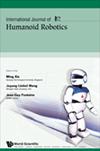The Application of Interactive Humanoid Robots in the History Education of Museums Under Artificial Intelligence
IF 1.6
4区 计算机科学
Q4 ROBOTICS
引用次数: 0
Abstract
The purpose is to improve the application of museum robots in museum scenes, enhance the service capabilities of robots in museums, break tourists’ boring concepts of museum environment, manual explanation, services, etc., and promote tourists’ exhibition experience. A method for sentiment analysis of humanoid robots in museums is proposed by studying the transformation of museums with the help of artificial intelligence (AI) technology, as well as the function and significance of museums in history education. First, the function of museums in history education and the role of AI in constructing intelligent museums are described. Second, on account of the multimodal sentiment analysis method of speech and emotion, a scenario model of the visitor museum is established. An uncertain reasoning method for robot service tasks based on Multi-entity Bayesian network (MEBN) is also proposed. Finally, the proposed model is validated by experiments. The results show that compared with the recognition rates of Arousal and Valence dimensions, the consistency correlation coefficient value of the Kalman filter is higher. The Consistency Correlation Coefficient (CCC) value of the Arousal dimension is 0.703, and the CCC value of the Valence dimension is 0.766. Besides, in different tour times, the proportion of services that tourists want to be provided with varies in different emotional states. From time [Formula: see text]1 to time [Formula: see text]2, the proportion of tourists who want to hear explanations of cultural relics dropped by 11.5%, while the proportion of tourists who want to be provided with tea service increased by 24%. This indicates that when the Kalman filter algorithm performs continuous emotion recognition of a multimodal fusion, the final emotion recognition accuracy is higher, and emotion analysis can help humanoid robots to be more intelligent and humanized. The proposed sentiment analysis based on the multimodal analysis and MEBN’s uncertainty reasoning method for robot service tasks not only broadens the practical application field of intelligent robots under human–computer interaction technology but also has important research significance for the innovative education development of museum history education.人工智能下交互式人形机器人在博物馆历史教育中的应用
目的是提高博物馆机器人在博物馆场景中的应用,增强博物馆机器人的服务能力,打破游客对博物馆环境、手工讲解、服务等枯燥乏味的观念,提升游客的展览体验。通过研究博物馆在人工智能技术的帮助下的转变,以及博物馆在历史教育中的作用和意义,提出了一种博物馆人形机器人情感分析的方法。首先,介绍了博物馆在历史教育中的作用以及人工智能在建设智能博物馆中的作用。其次,基于言语和情感的多模态情感分析方法,建立了游客博物馆的场景模型。提出了一种基于多实体贝叶斯网络的机器人服务任务不确定推理方法。最后,通过实验验证了该模型的有效性。结果表明,与唤醒维和价维的识别率相比,卡尔曼滤波器的一致性相关系数值更高。唤醒维度的一致性相关系数(CCC)值为0.703,价维度的CCC值为0.766。此外,在不同的旅游时间,游客希望获得的服务比例在不同的情绪状态下也有所不同。从[公式:见正文]1到[公式:看正文]2,希望听取文物讲解的游客比例下降了11.5%,而希望获得茶水服务的游客比例增加了24%。这表明,当卡尔曼滤波算法进行多模态融合的连续情绪识别时,最终的情绪识别精度更高,情绪分析可以帮助人形机器人更加智能和人性化。所提出的基于多模态分析的情感分析和MEBN的机器人服务任务不确定性推理方法,不仅拓宽了智能机器人在人机交互技术下的实际应用领域,而且对博物馆历史教育的创新教育发展具有重要的研究意义。
本文章由计算机程序翻译,如有差异,请以英文原文为准。
求助全文
约1分钟内获得全文
求助全文
来源期刊
CiteScore
3.50
自引率
13.30%
发文量
29
审稿时长
6 months
期刊介绍:
The International Journal of Humanoid Robotics (IJHR) covers all subjects on the mind and body of humanoid robots. It is dedicated to advancing new theories, new techniques, and new implementations contributing to the successful achievement of future robots which not only imitate human beings, but also serve human beings. While IJHR encourages the contribution of original papers which are solidly grounded on proven theories or experimental procedures, the journal also encourages the contribution of innovative papers which venture into the new, frontier areas in robotics. Such papers need not necessarily demonstrate, in the early stages of research and development, the full potential of new findings on a physical or virtual robot.
IJHR welcomes original papers in the following categories:
Research papers, which disseminate scientific findings contributing to solving technical issues underlying the development of humanoid robots, or biologically-inspired robots, having multiple functionality related to either physical capabilities (i.e. motion) or mental capabilities (i.e. intelligence)
Review articles, which describe, in non-technical terms, the latest in basic theories, principles, and algorithmic solutions
Short articles (e.g. feature articles and dialogues), which discuss the latest significant achievements and the future trends in robotics R&D
Papers on curriculum development in humanoid robot education
Book reviews.

 求助内容:
求助内容: 应助结果提醒方式:
应助结果提醒方式:


